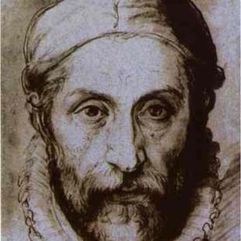

Giuseppe Arcimboldo
1527 - 1593
Giuseppe Arcimboldo, also spelled Arcimboldi, was an Italian Renaissance painter best known for creating imaginative portrait heads made entirely of objects such as fruits, vegetables, flowers, fish and books.
These works form a distinct category from his other productions. He was a conventional court painter of portraits for three Holy Roman Emperors in Vienna and Prague; also producing religious subjects and, among other things, a series of coloured drawings of exotic animals in the imperial menagerie. He specialized in grotesque symbolical compositions of fruits, animals, landscapes, or various inanimate objects arranged into human forms.
The still life portraits were clearly partly intended as curiosities to amuse the court, but critics have speculated as to how seriously they engaged with Renaissance Neo-Platonism or other intellectual currents of the day.
Biography
Giuseppe's father, Biagio Arcimboldo, was an artist of Milan, Italy. Like his father, Giuseppe Arcimboldo started his career as a designer for stained glass and frescoes at local cathedrals when he was 21 years old.
In 1562, he became court portraitist to Ferdinand I at the Habsburg court in Vienna, Austria and later, to Maximilian II and his son Rudolf II at the court in Prague. He was also the court decorator and costume designer. Augustus, Elector of Saxony, who visited Vienna in 1570 and 1573, saw Arcimboldo's work and commissioned a copy of his The Four Seasons which incorporates his own monarchic symbols.
Arcimboldo's conventional work, on traditional religious subjects, has fallen into oblivion, but his portraits of human heads made up of vegetables, plants, fruits, sea creatures and tree roots, were greatly admired by his contemporaries and remain a source of fascination today.
At a distance, his portraits look like normal human portraits. However, individual objects in each portrait actually overlap together to make various human anatomical shapes. They were carefully constructed by his imagination. The assembled objects in each portrait were not random: each was related by characterization. In the portrait now represented by several copies called The Librarian, Arcimboldo used objects that signified the book culture at that time, such as the curtain that created individual study rooms in a library. The animal tails, which became the beard of the portrait, were used as dusters. By using everyday objects, the portraits were decoration and still-life paintings at the same time. His works showed not only nature and human beings, but also how closely they were related.
After a portrait was released to the public, some scholars, who had a close relationship with the book culture at that time, argued that the portrait ridiculed their scholarship. In fact, Arcimboldo criticized rich people's misbehavior and showed others what happened at that time through his art. In The Librarian, although the painting might have appeared ridiculous, it also contained a criticism of wealthy people who collected books only to own them, rather than to read them.
Art critics debate whether his paintings were whimsical or the product of a deranged mind. A majority of scholars hold to the view, however, that given the Renaissance fascination with riddles, puzzles, and the bizarre (see, for example, the grotesque heads of Leonardo da Vinci), Arcimboldo, far from being mentally imbalanced, catered to the taste of his times.
Arcimboldo died in Milan, Italy where he had retired after leaving the Prague service. It was during this last phase of his career that he produced the composite portrait of Rudolph II (see above), as well as his self-portrait as the Four Seasons. His Italian contemporaries honored him with poetry and manuscripts celebrating his illustrious career.
When the Swedish army invaded Prague in 1648, during the Thirty Years' War, many of Arcimboldo's paintings were taken from Rudolf II's collection.
His works can be found in Vienna's Kunsthistorisches Museum and the Habsburg Schloss Ambras in Innsbruck; the Louvre in Paris; as well as in numerous museums in Sweden. In Italy, his work is in Cremona, Brescia, and the Uffizi Gallery in Florence. The Wadsworth Atheneum in Hartford, Connecticut; the Denver Art Museum in Denver, Colorado; the Menil Foundation in Houston, Texas; and the Candie Museum in Guernsey also hold Arcimboldo works. The Real Academia de Bellas Artes de San Fernando in Madrid owns a painting of The Spring by Arcimboldo.
He is known as a 16th-century Mannerist. A transitional period from 1520 to 1590, Mannerism adopted some artistic elements from the High Renaissance and influenced other elements in the Baroque period. A Mannerist tended to show close relationships between human and nature. Arcimboldo also tried to show his appreciation of nature through his portraits. In The Spring, the human portrait was composed of only various spring flowers and plants. From the hat to the neck, every part of the portrait, even the lips and nose, was composed of flowers, while the body was composed of plants. On the other hand, in The Winter, the human was composed mostly of roots of trees. Some leaves from evergreen trees and the branches of other trees became hair, while a straw mat became the costume of the human portrait.
Text courtesy of Wikipedia, 2024





















